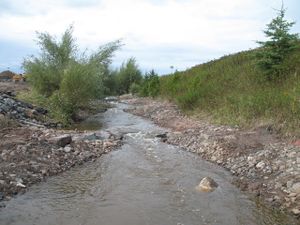
Difference between revisions of "Category:Level 3 - Best management practices/Structural practices/Step pool"
m |
m |
||
| Line 1: | Line 1: | ||
[[File:Step pool.jpg|300px|thumb|alt=image of step pool|<font size=3>Stormwater step pool. Courtesy of Limnotech.</font size>]] | [[File:Step pool.jpg|300px|thumb|alt=image of step pool|<font size=3>Stormwater step pool. Courtesy of Limnotech.</font size>]] | ||
| − | <font size=5>[[High-gradient stormwater step-pool swale|Main page for stormwater step pool]]</font size> | + | <font size=5>[[High-gradient stormwater step-pool swale|'''Main page for stormwater step pool''']]</font size> |
Stormwater step pools are defined by design features that address higher energy flows due to more dramatic slopes than <span title="Dry swales, sometimes called grass swales, are similar to bioretention cells but are configured as shallow, linear channels. They typically have vegetative cover such as turf or native perennial grasses. Dry swales may be constructed as filtration or infiltration practices, depending on soils."> [https://stormwater.pca.state.mn.us/index.php?title=Dry_swale_(Grass_swale) '''dry swales''']</span> or <span title="Wet swales occur when the water table is located very close to the surface or water does not readily drain out of the swale. A wet swale acts as a very long and linear shallow biofiltration or linear wetland treatment system."> [https://stormwater.pca.state.mn.us/index.php?title=Wet_swale_(wetland_channel) '''wet swales''']</span>. Using a series of pools, riffle grade control, <span title="A species that has been observed in the form of a naturally occurring and self-sustaining population in historical times. Non-natives do not meet this definition."> '''native species'''</span> vegetation and a sand seepage filter bed, flow velocities are reduced, treated, and, where applicable, infiltrated. The physical characteristics of the stormwater step pools are similar to [https://cfpub.epa.gov/watertrain/moduleFrame.cfm?parent_object_id=1199 Rosgen A or B stream classification types], where “bedform occurs as a step/pool, cascading channel which often stores large amounts of sediment in the pools associated with debris dams” ([https://stormwater.pca.state.mn.us/index.php?title=References_for_high-gradient_stormwater_step-pool_swale Rosgen, 1996]). These structures feature surface/subsurface runoff storage seams and an energy dissipation design that is aimed at attenuating the flow to a desired level through energy and hydraulic power equivalency principles ([https://stormwater.pca.state.mn.us/index.php?title=References_for_high-gradient_stormwater_step-pool_swale Anne Arundel County, 2009]). Stormwater step pools are designed with a wide variety of [https://stormwater.pca.state.mn.us/index.php?title=Plants_for_swales native plant species] depending on the hydraulic conditions and expected post-flow soil moisture at any given point within the stormwater step pool. | Stormwater step pools are defined by design features that address higher energy flows due to more dramatic slopes than <span title="Dry swales, sometimes called grass swales, are similar to bioretention cells but are configured as shallow, linear channels. They typically have vegetative cover such as turf or native perennial grasses. Dry swales may be constructed as filtration or infiltration practices, depending on soils."> [https://stormwater.pca.state.mn.us/index.php?title=Dry_swale_(Grass_swale) '''dry swales''']</span> or <span title="Wet swales occur when the water table is located very close to the surface or water does not readily drain out of the swale. A wet swale acts as a very long and linear shallow biofiltration or linear wetland treatment system."> [https://stormwater.pca.state.mn.us/index.php?title=Wet_swale_(wetland_channel) '''wet swales''']</span>. Using a series of pools, riffle grade control, <span title="A species that has been observed in the form of a naturally occurring and self-sustaining population in historical times. Non-natives do not meet this definition."> '''native species'''</span> vegetation and a sand seepage filter bed, flow velocities are reduced, treated, and, where applicable, infiltrated. The physical characteristics of the stormwater step pools are similar to [https://cfpub.epa.gov/watertrain/moduleFrame.cfm?parent_object_id=1199 Rosgen A or B stream classification types], where “bedform occurs as a step/pool, cascading channel which often stores large amounts of sediment in the pools associated with debris dams” ([https://stormwater.pca.state.mn.us/index.php?title=References_for_high-gradient_stormwater_step-pool_swale Rosgen, 1996]). These structures feature surface/subsurface runoff storage seams and an energy dissipation design that is aimed at attenuating the flow to a desired level through energy and hydraulic power equivalency principles ([https://stormwater.pca.state.mn.us/index.php?title=References_for_high-gradient_stormwater_step-pool_swale Anne Arundel County, 2009]). Stormwater step pools are designed with a wide variety of [https://stormwater.pca.state.mn.us/index.php?title=Plants_for_swales native plant species] depending on the hydraulic conditions and expected post-flow soil moisture at any given point within the stormwater step pool. | ||
Latest revision as of 14:14, 12 February 2023
Main page for stormwater step pool
Stormwater step pools are defined by design features that address higher energy flows due to more dramatic slopes than dry swales or wet swales. Using a series of pools, riffle grade control, native species vegetation and a sand seepage filter bed, flow velocities are reduced, treated, and, where applicable, infiltrated. The physical characteristics of the stormwater step pools are similar to Rosgen A or B stream classification types, where “bedform occurs as a step/pool, cascading channel which often stores large amounts of sediment in the pools associated with debris dams” (Rosgen, 1996). These structures feature surface/subsurface runoff storage seams and an energy dissipation design that is aimed at attenuating the flow to a desired level through energy and hydraulic power equivalency principles (Anne Arundel County, 2009). Stormwater step pools are designed with a wide variety of native plant species depending on the hydraulic conditions and expected post-flow soil moisture at any given point within the stormwater step pool.
This page provides links to pages that provide information on stormwater step pools.
Subcategories
This category has only the following subcategory.
Pages in category "Level 3 - Best management practices/Structural practices/Step pool"
The following 22 pages are in this category, out of 22 total.
C
O
R
- References for filtration
- References for high-gradient stormwater step-pool swale
- Requirements, recommendations and information for using swale side slope as a BMP in the MIDS calculator
- Requirements, recommendations and information for using swale with an underdrain as a BMP in the MIDS calculator
- Requirements, recommendations and information for using swale without an underdrain as a BMP in the MIDS calculator
- Requirements, recommendations and information for using wet swale as a BMP in the MIDS calculator
- Routing stormwater runoff to swales and swale side slopes in the MIDS Calculator
Media in category "Level 3 - Best management practices/Structural practices/Step pool"
The following 3 files are in this category, out of 3 total.
- Stormwater-Step-Pool.dwg ; 866 KB
- VARIOUS CHECK DAMS.dwg ; 382 KB
This page was last edited on 12 February 2023, at 14:14.
